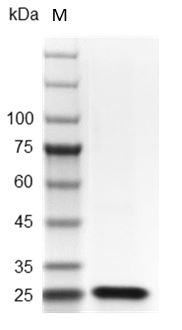| Product name | Mouse FGF-21 Protein, His tag (Animal-Free) |
| Sequence | Amino acid sequence derived from Mouse FGF-21 (Met 29-Asn 210) (Q9JJN1) was expressed with 6×His tag at the N-terminus |
| Applications | His tag |
| Applications notes | Mouse |
| Activity | Measure by its ability to induce proliferation in NIH‑3T3 mouse embryonic fibroblast cells in the presence of mouse Klotho beta and heparin. The ED₅₀ for this effect is < 2 μg/mL. |
| Protein length | The recombinant Mouse FGF-21 Protein consists of 182 amino acids and predicts a molecular mass of 20.76 kDa |
| Preparation method | E. coli |
| Purity | > 98% as determined by SDS-PAGE. |
| Alternative | Fgf8c |
| Formulation | The protein was lyophilized from sterile PBS, pH 8.0. If you have any concerns or special requirements, please confirm with us. |
| Features & Benefits | Endotoxin: <0.1 EU per 1 μg of the protein by the LAL method. |
| Molecular weight | 20.76 kDa |
| Usage notes | Always centrifuge tubes before opening. It is recommended to reconstitute the lyophilized recombinant protein to a concentration of 0.1-1 mg/mL using the buffer we provided, and keep at room temperature for at least 20 min to fully dissolve. Please avoid vortex vigorously |
| Storage instructions | Lyophilized protein product should be stored desiccated below -18°C. Upon reconstitution, the protein should be stored at 4°C between 2-7 days and for future use below -18°C. For long term storage it is recommended to add a carrier protein (5% HSA , 10%FBS or 0.1%BSA). Please prevent freeze-thaw cycles |
| Shipping | The product is shipped with blue ice. |
| Precautions | The product listed herein is for research use only and is not intended for use in human or clinical diagnosis. Suggested applications of our products are not recommendations to use our products in violation of any patent or as a license. We cannot be responsible for patent infringements or other violations that may occur with the use of this product. |
| Background | Fibroblast growth factor 21 (FGF-21) is a member of the FGF gene family. Based on its structure, FGF-21 is further classified into a subfamily of FGFs along with FGF-19 and-23. At the amino acid sequence level, mature mouse FGF-21 is 81% and 92% identical to mature human and rat FGF-21, respectively.The biological activity of FGF-21 requires binding to Klotho beta, a co-receptor that is in complex with cell surface FGF receptors (FGF R). Binding of FGF-21 to Klotho beta facilitates FGF R activation and autophosphorylation resulting in the initiation of multiple downstream signaling cascades. FGF-21 cannot independently bind to FGF Rs, thus its effects are restricted to target tissues that express Klotho beta. FGF-21 functions as a physiological regulator of cellular metabolism, including glucose uptake in adipocytes and cellular sensitivity to insulin. FGF-21 is basally expressed in the pancreas, thymus, and liver, as well as in adipose tissue.Modulation of FGF-21 expression is associated with a number of metabolic disorders, including obesity and diabetesactivity |
| Alternative | Fgf8c |
| Accession | Q9JJN1 |

You must be logged in to post a review.
Reviews
There are no reviews yet.